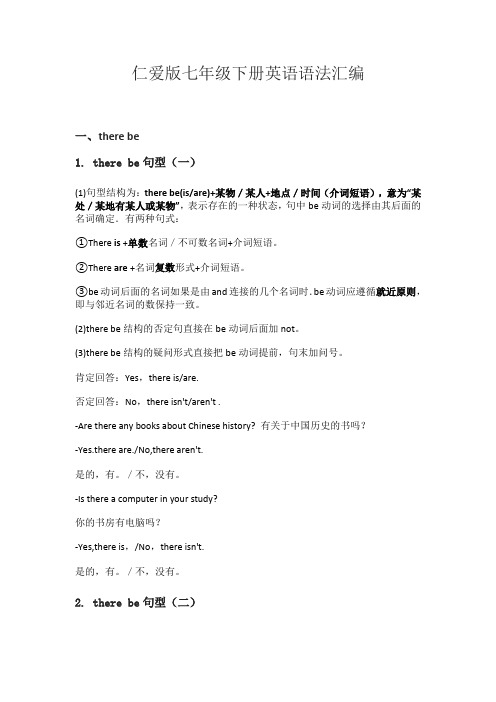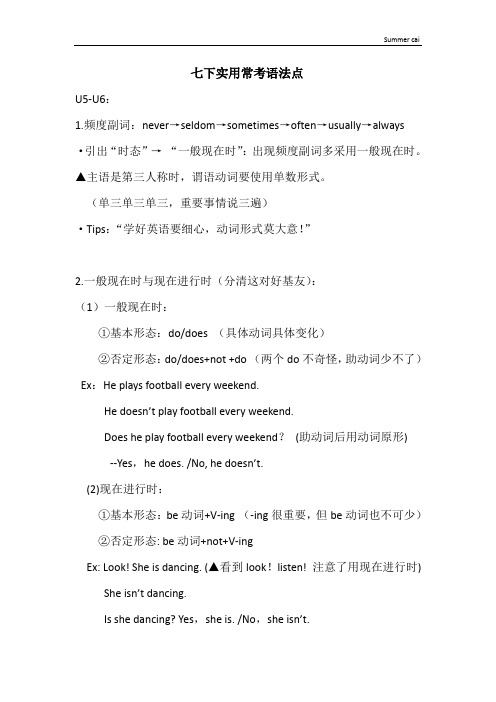仁爱七年级下语法
仁爱版七年级下册英语语法汇编

仁爱版七年级下册英语语法汇编
一、there be
1. there be句型(一)
(1)句型结构为:there be(is/are)+某物/某人+地点/时间(介词短语),意为“某处/某地有某人或某物”,表示存在的一种状态,句中be动词的选择由其后面的名词确定.有两种句式:
①There is +单数名词/不可数名词+介词短语。
②There are +名词复数形式+介词短语。
③be动词后面的名词如果是由and连接的几个名词时.be动词应遵循就近原则,即与邻近名词的数保持一致。
(2)there be结构的否定句直接在be动词后面加not。
(3)there be结构的疑问形式直接把be动词提前,句末加问号。
肯定回答:Yes,there is/are.
否定回答:No,there isn't/aren't .
-Are there any books about Chinese history? 有关于中国历史的书吗?
-Yes.there are./No,there aren't.
是的,有。
/不,没有。
-Is there a computer in your study?
你的书房有电脑吗?
-Yes,there is,/No,there isn't.
是的,有。
/不,没有。
2. there be句型(二)。
仁爱英语七年级下册重点语法知识归纳

七年级下期末考试复习一、名词的数可数名词的复数在名词后加“-s/-es”,不可数名词没有复数重点记忆:可数名词:bus-buses box-boxes knife-knives man-men woman-women snowman-snowmen baby-babies glass-glasses family-families tomato-tomatoes(马铃薯) foot-feet mouse-mice child-children shelf-shelvesactivity-activities country-countries mouse-mice wish-wishes leaf-leaves不可数名词:hair chicken rice bread water milk juice food homework work meat单复数都是同一个词(单复同形):Chinese Japanese people sheep(绵羊)一、冠词元音因素前用“an”,辅音因素前用“a”重点记忆:an apple an English teacher an office worker an American an “eleven”一个十一an eraser an egg an orange an ear an actor an office an order (一个命令) an email(一封邮件)冠词“the”是特指,写作时一般用于第二次出现的人和事物二、数词重点记忆:first second third fifth eighth ninth twelfth fifteenth fortieth三、动词1.动词的单三形式:一般加“-s/-es”, 部分双写最后一个字母,辅音+y结尾,要把“y”变成“i”,再加“es”,具体规则参考课本,下面列举出需要重点记忆的单词:do-does have-has teach-teaches go-goes catch-catches fly-flies try-tries study-studies watch-watchesstudy-studies wish-wishes2.动词的“-ing”形式,一般情况下在动词后加“-ing”,不发音的“e”结尾要去“e”后才加“-ing”,如:have-having live-living come-coming drive-driving make-making ride-riding use-using write-writing change-changing shine-shining prepare-preparing share-sharing arrive-arriving believe-believing 部分需双写最后一个字母后再加“-ing”,如:swim-swimming shop-shopping get-getting sit-sitting run-running3.动词的过去式,一般情况下加“-ed”,辅音加“y”结尾,先把“y”变成“i”再加“-ed”,部分要双写最后一个字母,部分是不规则变化,具体参考课本。
仁爱英语七年级下语法总结归纳课件-课件

e.g. How much money does he make per month?
How much does the bike cost?
11、how long “多久”,用于对 一段时间提问。 “多长” 用于对长度提问。
e.g. How long can I keep the book? How long is the river?
e.g. Who is your favorite sports star? 19、whose “谁的”,用于对物主提问。 e.g. Whose bag is on the desk? 20、why “为什么”,用于对原因提问。
e.g. Why do you like English? Because it’s interesting.
原形
come cost eat fall find fly forget get
过去式
came cost ate fell found
flew forgot got
原形
give go have has keep know let
过去式
gave went hadkept Fra biblioteknew let
原形
lose make meet put read run say
_____ bus.
5. 4.They are having lunchin_____ the restaurant.
6. 5.We are talkinagbo__u_t____ the news.
7. 6. I like talking _t_o___you. 8. 7.We have 3 lessonisn______the
仁爱英语七年级下册实用常考语法点

七下实用常考语法点U5-U6:1.频度副词:never→seldom→sometimes→often→usually→always ·引出“时态”→“一般现在时”:出现频度副词多采用一般现在时。
▲主语是第三人称时,谓语动词要使用单数形式。
(单三单三单三,重要事情说三遍)·Tips:“学好英语要细心,动词形式莫大意!”2.一般现在时与现在进行时(分清这对好基友):(1)一般现在时:①基本形态:do/does (具体动词具体变化)②否定形态:do/does+not +do (两个do不奇怪,助动词少不了)Ex:He plays football every weekend.He doesn’t play football every weekend.Does he play football every weekend?(助动词后用动词原形)--Yes,he does. /No, he doesn’t.(2)现在进行时:①基本形态:be动词+V-ing (-ing很重要,但be动词也不可少)②否定形态: be动词+not+V-ingEx: Look! She is dancing. (▲看到look!listen! 注意了用现在进行时) She isn’t dancing.Is she dancing? Yes,she is. /No,she isn’t.3.人称代词:▲①It’s my book. –No,it’s mine.②She teaches them English. (动宾)③It’s good for us to do sports often.(介宾)·记忆:充当宾语用宾格,修饰名词用形代,单个放句尾用名代。
4.There be句型★(初中大重点):①必考:“就近原则”(is/are的选择看最近的名词)▲易错:There is some bread in the desk.(some虽然表“一些”,但在这里是修饰不可数名词,就近要看名词来定be动词,而不是看到some就用are,正中错误陷阱。
语法总结仁爱版英语七年级下册

)语法:(1)公式:主语+be(am,is,are)+v-ing+其他,否定:主语+be(am,is,are)+not+v-ing+其他(2)用法:现在或者现阶段正在进行的动作或者状态(3)规则变化:3+:直接+,去e+,双写+ ※特殊变化:lie-lying,die-dying(4)标志词:Look!Listen!now, at the moment(此时此刻)(5)特殊用法:现在进行表将来表示移动的瞬间动词的现在进行时可以表示将来含义:come, go, fly, move, leave, die等e.g:She is leaving for Shanghai.(1)公式:主语+v-ed(过去式)+其他,否定要借助动词did:主语+didn't+v-原+其他主语+was/were+其他,否定直接加not:主语+was/were+not+其他(2)用法:过去的动作或者状态(3)规则变化:4+(+ed):直接+,去e+,双写+,变y+(4)标志词:①yesterday②ago③last④过去时间短语※in the 1960s(世纪+1)译为二十世纪六十年代3.there be句型(有)(1)there be+某人/某物+方位介词+地点否定:there be+not+某人/某物+方位介词+地点疑问:Be+there+某人/某物+方位介词+地点?特殊疑问:What is 方位介词+地点?(2)句型:there be++方位介词+地点某处有某人/某物正在做某事there be+某人/某物+方位介词+地点某处有某人/某物被...e.g.:There are many old people living in our community. 有很多老人住在我们小区。
e.g.: There are many trees planted in our school.有很多树种在我们学校。
(3)就近原则:there be+某人/某物(主语)+方位介词+地点be动词的选择跟随主语走,多个主语时,根据离be动词近的主语决定。
仁爱英语七年级下册语言点、语法归纳

仁爱英语七年级下册语言点、语法归纳仁爱英语七年级下册的语言点、语法归纳如下:1. 动词的一般现在时- 用于表示经常性、习惯性的动作或存在;- 句子结构:主语 + 动词原形(第三人称单数加-s);- 例句:She goes to school every day.2. 形容词的比较级和最高级- 用于比较两个人或物的特征;- 变化形式:比较级(加-er)和最高级(加-est或在前面加most);- 例句:She is taller than her sister.3. 一般过去时- 用于表示过去发生的动作或存在;- 句子结构:主语 + 动词过去式;- 例句:We visited the Great Wall last week.4. there be句型- 用于描述存在或发生在某个地方的人或事物;- 句子结构:There + be动词 + 名词;- 例句:There is a cat in the room.5. 情态动词can和must- can表示能力、允许或请求等;- must表示必须或推测等;- 例句:You can play the piano.- 例句:You must finish your homework.6. 简单陈述句的一般疑问句- 用于询问是否是事实或陈述的正确性;- 句子结构:助动词提到句首 + 主语 + 动词;- 例句:Are you a teacher?7. 时间状语从句- 用于引导表示时间的从句;- 句子结构:时间状语 + 主句;- 例句:When I was young, I liked to play football.8. 动词的-ing形式- 表示正在进行的动作或状态;- 句子结构:主语 + be动词 + 动词-ing;- 例句:She is running in the park.9. 介词的使用10. 物主代词的使用11. 数词的使用12. 够则句的使用13. 句子的省略14. 名词的复数形式及其变化规则15. 以人称代词作为主语的句子16. 特殊疑问句17. 时态的转换和语态的改变18. 定语从句19. 情态动词的否定形式20. 短语动词的使用和变化等等。
七年级下册仁爱版英语语法归纳
七年级下册仁爱版英语语法归纳1. 一般现在时态 (Simple Present Tense)- 用于对经常性或习惯性事件的陈述,或表示客观事实。
- 结构:主语 + 动词原形 (+ 其他补充信息)- 例句:I play tennis every Saturday. (我每个星期六都打网球)2. 一般过去时态 (Simple Past Tense)- 用于过去发生的动作或情况的陈述。
- 结构:主语 + 动词过去式 (+ 其他补充信息)- 例句:She watched a movie last night. (她昨晚看了一部电影)3. 一般将来时态 (Simple Future Tense)- 用于对将来的动作或情况的陈述。
可以通过 will 或 be goingto 表示。
- 结构:主语 + will/shall + 动词原形 (或主语 + be going to + 动词原形) (+ 其他补充信息)- 例句:They will go on a trip next month. (他们下个月将去旅行)4. 现在进行时态 (Present Continuous Tense)- 用于对正在进行的动作或情况的陈述。
- 结构:主语 + be动词 (am/is/are) + 动词的现在分词 (+ 其他补充信息)- 例句:She is studying in the library now. (她现在正在图书馆学习)5. 过去进行时态 (Past Continuous Tense)- 用于过去某个时间段内正在进行的动作或情况的陈述。
- 结构:主语 + was/were + 动词的现在分词 (+ 其他补充信息) - 例句:We were playing soccer all afternoon yesterday. (昨天下午我们一直在踢足球)6. 现在完成时态 (Present Perfect Tense)- 用于表示过去发生的动作对现在造成的影响,或挥之不去的经历。
七年级下册英语语法重点仁爱版
⼀. 词汇 ⑴单词 1. 介词:in, on, under, behind, near, at, of 1). in表⽰;中;在内。
例如: in our class 在我们班上 in my bag 在我的书包⾥ in the desk 在桌⼦⾥ in the classroom 在教室⾥ 2). on 表⽰;在;;上;。
例如: on the wall 在墙上 on the desk 在桌⼦上 on the blackboard 在⿊板上 3). under表⽰;在;;下;。
例如: under the tree 在树下 under the chair 在椅⼦下 under the bed 在床下 4). behind表⽰;在;;后⾯;。
例如: behind the door 在门后 behind the tree 在树后 5). near表⽰;在;;附近;。
例如: near the teachers desk 在讲桌附近 near the bed 在床附近 6). at表⽰;在;;处;。
例如: at school 在学校 at home 在家 at the door 在门⼝ 7). of 表⽰的;。
例如: a picture of our classroom 我们教室的⼀幅画 a map of China ⼀张中国地图 nbsp; 2. 冠词 a / an / the: 冠词⼀般位于所限定的名词前,⽤来署名名词所指的⼈或事物。
冠词有不定冠词和定冠词两种。
不定冠词有两个形式,即a和an。
a⽤在以辅⾳⾳素开头的词前,如a book; an⽤在以元⾳⾳素开头的字母前,如an apple. a或an与可数名词单数连⽤,泛指某类⼈或某物中的⼀个。
This is a cat. 这是⼀只猫。
It#39;s an English book. 这是⼀本英语书。
His father is a worker. 他的爸爸是个⼯⼈。
仁爱版七年级下册英语重要的语法
七年级英语(仁爱版)下册语言点归纳Unit 5 School LifeTopic 1 How do you usually go to school?一. 重点词汇:一). 交通工具:bike, ship, boat, bus, taxi, subway, train, plane二). 频率副词:never, seldom, sometimes, often, usually, always三). 常用动词:catch, walk, ride, finish, read, clean, dance, listen四). 重点词组:1. by bike / ship / boat / bus / taxi…骑自行车/搭乘轮船/船只/公共汽车/的士2. on foot 步行3. three of us 我们当中的三个4. on weekdays 在工作日5. go to school on foot = walk to school 步行去上学go home by subway = take the subway home 坐地铁回家go to school by bike = go to school on a bike = ride a bike to school 骑自行车去上学go to the zoo by bus = go to the zoo on a bus = take a bus to the zoo 坐公共汽车去动物园go to the Great Wall by car = go to the Great Wall in a car = drive a car to the Great Wall 开车去长城6. get up early / late 早起/ 晚起7. do my homework at school 在学校做家作8. help my parents 帮助我父母9. know about 知道关于…10. the school life 学校生活11. take a yellow school bus 乘坐黄色校车12. have a short break = have a short rest 短暂休息13. in their free time = in their spare time 在他们的空闲时间14. and so on 等等15. read books 看书16. go swimming / dancing 去游泳/ 跳舞:go doing sth. 去从事某项娱乐活动17. clean the house 打扫房子18. listen to music 听音乐19. once / twice / three times a week 一个星期一次/两次/三次20. for a little while 一会儿二. 重点句型及重点语言点:1. Happy New Year! The same to you! 新年快乐!同喜同乐!注意:Happy birthday! 回答应为Thank you!2. How do you usually come to school? 你通常怎样来学校?How引导的特殊疑问句用来询问去某地的交通方式。
七年级英语仁爱下册知识点
七年级英语仁爱下册知识点一、语法知识基本语法:主语+谓语+宾语。
以及各个时态的构成和用法。
名词:可数名词和不可数名词,单数和复数名词的变化。
代词:人称代词、物主代词、反身代词、指示代词、不定代词的用法。
形容词:前置和后置形容词的用法及比较级和最高级的构成。
副词:修饰动词、形容词和其他副词,比较级和最高级的构成。
动词:被动语态、不定式、现在分词和过去分词的用法。
介词:表示时间、地点、方向等不同含义的介词的用法。
连词:并列连词和从属连词的用法。
二、听力技巧听力技巧在英语学习过程中非常重要。
以下是学习英语听力的一些技巧:1. 朗读原音通过朗读英文来加强听力,特别是英文模拟。
2. 接受各种来源的英语通过不同来源的英语录音来提高听力水平。
3. 注重意识和表达主动聆听并尝试回答问题。
4. 反复练习反复听一段英文录音,让自己逐渐理解录音中的语言。
三、阅读技巧提高阅读技巧是学习英语过程中的关键之一。
以下是一些阅读技巧:1. 了解关键词了解文章中的关键词汇,学习他们的意思和用法。
2. 省略不重要的内容快速浏览文章,将重要的细节与不重要的细节区分开来。
3. 使用提示词使用各种提示词,例如:数字、首字母缩写、引号等来帮助理解文章。
4. 了解文章结构了解文章的结构,可以帮助理解和记忆文章的内容。
四、词汇积累扩充词汇量有助于提高英语水平。
学习新单词及其用法是达到这一目标的关键。
词根词缀:词根词缀是帮助记忆词汇的一种很好方式。
短语和表达:学习一些固定用法的短语和表达,提高阅读和表达能力。
五、口语练习口语练习是提高英语能力和学习英语的重要方法。
以下是一些口语练习技巧:1. 学习发音学习标准的英语发音,特别是元音和辅音。
2. 反复练习通过反复练习来加强口语能力。
3. 微笑说出话语通过微笑来减轻焦虑和压力,加强口语表达能力。
4. 合理使用单词合理使用单词,特别是在表达和发音方面。
以上是七年级英语仁爱下册的一些重要知识点和技巧。
在学习英语过程中,重要的是通过不断的练习和不断地积累来提高英语水平。
- 1、下载文档前请自行甄别文档内容的完整性,平台不提供额外的编辑、内容补充、找答案等附加服务。
- 2、"仅部分预览"的文档,不可在线预览部分如存在完整性等问题,可反馈申请退款(可完整预览的文档不适用该条件!)。
- 3、如文档侵犯您的权益,请联系客服反馈,我们会尽快为您处理(人工客服工作时间:9:00-18:30)。
Topic 11.询问交通方式用how。
如:How do you usually go to Chongqing?你通常怎样去重庆?回答常用:①by+交通工具名称。
如:by bus/subway/train乘公共汽车/地铁/火车by boat ship/sea坐船by plane/air/airplane乘飞机②in/on+冠词/形容词性物主代词/名同所有格十交通工具名称。
如:on a bus乘公共汽车in my car乘我的小汽车on Jim's bike骑吉姆的自行车He goes to Beijing on a train他乘火车去北京。
③on foot意为“步行”。
如:Xiao Hong goes to the park on foot小红步行去公园。
2. 频率副词英语中表频率的副词有:never(从不),seldom(很少),sometimes(有时),often(经常),usually(通常),always(总是),它们所表达的频率依次变大。
⑴频率副词在句中常放在be动词,情态动诃,助动词之后,实义动词之前。
如:She is always busy with her work.她总是忙于工作。
He often gets up at 6 in the morning 他经常早上六点钟起床。
⑵对频率副词提问用how often。
如:How often do you go to Chongqing? 你多久去一次重庆?I sometimes go to Chongqing我有时去重庆。
⑶How often意为“多久一次”,用来对频率提问。
用频度副词或单位时间内的次数来回。
如:three times a week,every day,often,seldom,always,never,sometimes,usually,every four weeks等。
-How often do you go swimming'?你多久游一次泳?-I go swimming four times a month.我一个月游四次。
3. ①go doing意为“去进行某种娱乐休闲活动”。
如:go dancing;去跳舞go shopping去购物go swimming击游泳go fishing去钓鱼go skating去滑冰go running去跑步go hiking去徒步旅行②play+球类名词,意为“打…..球”。
如:play basketball打篮球play soccer/football踢足球play volleyball打排球③play +the+乐器,意为“弹奏某种乐器”。
如:play the guitar弹吉他play the piano弹钢琴4.一般现在时⑴一般现在时指经常或习惯性发生的动作或存在的状态。
常和usually. never, always, often, sometimes, seldom, every day/week, once/twice a week等时间状语连用。
如:He plays basketball twice a week 他一周打两次篮球。
She often rides a bike to school 她经常骑自行车上学。
⑵一般现在时的谓语动词用动词原形或动词的第三人称单数形式表示:其动词的第三人称单数形式构成规则如下:①一般在动词词尾加一s。
如:drive-dives get-gets②以字母s,o,x,thu或sh结尾的动词在词尾加-'s。
如:go-goes watch-watches③以辅音字母+y结尾的动词,先变y为i,再加-es。
如:Study-studies fly-flies1.现在进行时⑴现在进行时表示正在发生或进行的动作,常与now, at the moment,look,listen等词语或者短语连用。
⑵结构:主语+be(is,am,are)+现在分词。
如:Mary is having lunch with her parents now 玛丽正和她的父母一起吃午餐。
They are doing their homework at home. 他们正在家里做家庭作业。
⑶动词的现在分词的构成规则:①一般在词尾加-ing。
如:drink-drinking②以不发音字母e结尾的动词,先去e,再加ing。
如:make-making close-closing have-having③以重读闭音节结尾的动词,且词尾只有一个辅音字母,应先双写这个辅音字母,再加ing。
如:Sit-sitting begin-beginning shop-shopping2.borrow,lend与keep(l)borrow意为“借入”,borrow sth. from sb意为“向某人借某物”。
如:May I borrow some money from you? 我可以向你借一些钱吗?(2)lend意为“借出”。
lend sb. sth.:lend sth. to sb意为“借给某人某物”。
如:Can you lend me a pen?= Can you lend a pen to me? 你能借给我一支钢笔吗?(3)keep意为“保存、保管”,要和一段时间连用。
如:You can keep the book for a week你能借这本书一周3. also.too.either和as well的用法(1)also意为“也”,用于肯定句中,位于be动词和情态动词之后,行为动词前面。
如:I also want to go shopping我也想去购物。
She is also a nurse她也是一个护士。
(2)too意为“也”,用于肯定句末,前面用逗号隔开。
如:The little boy is in Class Five,Grade Seven,too。
这个男孩也在七年级五班。
(3)either意为“也”,用于否定句末,前面用逗号隔开:如:I don't want to go to school,either。
我也不想去上学。
(4)as well意为“也”,用于肯定句末。
如:She is a middle school student as well她也是一个中学生。
Topic 31. must的用法(l)must意为“必须”。
如:You must do your homework at school. 你必须在学校做作业。
(2)must表示推测、猜测,意为“一定,肯定”,用于肯定句。
如:You must like English very much. 你肯定很喜欢英语。
(3)在否定句中表示推测应该用can't。
如:He can't be Mr. Lee. He is working now 他一定不是李先生,他正在工作。
2. 特殊疑问词小结(l)what意为“什么”。
如:what class什么班级what time几点what color什么颜色what kind of什么种类的what day星期几(2)which+n.意为“哪一个(些)”。
(3)问方式及状况:how问数量多少:how many+可数名词复数how much+不可数名词问多少钱:how much+ -般疑问句(4)问频率:How often+ -般疑问句,意为“多久一次…..”。
(5)问多长时间或物体有多长:how long (6)问年龄:how old(7问多远/多高/多宽how far/high/tall/wide(8)问原因:why(9)问地点:where(10)问何时:when(11)问是谁whoTopic 11. there be句型(一)(1)句型结构为:there be(is/are)+某物/某人+地点/时间(介词短语),意为“某处/某地有某人或某物”,表示存在的一种状态,句中be动词的选择由其后面的名词确定.有两种句式:①There is+单数名词/不可数名词+介词短语:如:There is a computer in the study 书房里有一台电脑。
There is some water in the bottle 瓶子里有一些水。
②There are+名词复数形式+介词短语。
如:There are some flowers in the garden 花园里有一些花。
③be动词后面的名词如果是由and连接的几个名词时.be动词应遵循就近原则,即与邻近名词的数保持一致。
There is a chair and two desks in the teacher's room. 老师的房间里有一把椅子和两张桌子。
There are two desks and a chair in the teacher's room. 老师的房间里有两张桌子和一把椅子。
(2)there be结构的否定句:there be结构的否定句直接在be动词后面加not。
如:There is an apple on the plate.盘子里有一个苹果。
There isn't an apple on the plate盘子里没有苹果。
(3)there be结构的一般疑问句及肯定、否定回答:there be结构的疑问形式直接把be动词提前,句末加问号。
肯定回答:Yes,there is/are.否定回答:No,there isn't/aren't .-Are there any books about Chinese history? 有关于中国历史的书吗?-Yes.there are./No,there aren't 是的,有。
/不,没有。
-Is there a computer in your study? 你的书房有电脑吗?-Yes,there is,/No,there isn't 是的,有。
/不,没有。
2. there be句型(二)(1)针对there be结构的名词提问,常常用what's+地点状语,名词无论是单数形式还是复数形式,be动词都用is,且常省略there。
如:There is a desk in the room. (对画线部分提问)房间里有张桌子。
——What's in the room?房间里面有什么?There are many students in the class room.(对画线部分提问)教室里有许多学生。
——What's in the classroom教室里面有什么?(2)针对there be结构中名词的数量提同,用how many或how much提问,后面要紧跟这个名词.如:There's a coat on the bed(对画线部分提问)在床上有一件衣服。
